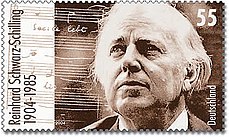20:
46:
198:
203:
193:
82:
100:, Schwarz-Schilling's music was often inspired by religious and spiritual themes. His tonal language follows in the tradition of
86:
135:
19:
39:
23:
The stamp was issued one the occasion of the 100th birthday of
Reinhard Schwarz-Schilling (Deutsche Post 2004).
53:
The son of a chemical manufacturer, Schwarz-Schilling embarked upon his musical studies in 1922, first in
101:
97:
188:
183:
45:
115:("The Commission"), composed between 1979 and 1982, although he also composed a wide range of
105:
74:
66:
131:(1957) and Introduction & Fugue for string orchestra (1948) have been recorded for CD.
70:
177:
120:
124:
199:
Recipients of the Cross of the Order of Merit of the
Federal Republic of Germany
158:(MGG2), biographical part, vol. 15 (Kassel: Bärenreiter, 2006), cc. 425–427.
116:
90:
78:
31:
109:
73:(piano) and Heinrich Boell (organ). From 1927 to 1929, he studied with
62:
54:
35:
58:
154:
Friederike
Wissmann: "Schwarz-Schilling, Reinhard", in:
204:
Academic staff of the Berlin
University of the Arts
104:and is strongly influenced by that of his teacher
81:. In 1938, he obtained a teaching position at the
49:Grave at St Matthias cemetery in Berlin-Tempelhof
57:and – interrupted by several extended breaks in
8:
89:). One of his most prominent pupils was
44:
18:
147:
127:works. His Symphony in C major(1963),
156:Die Musik in Geschichte und Gegenwart
7:
14:
134:His son is the German politician
1:
194:20th-century German composers
108:. His best known work is the
87:Berlin University of the Arts
136:Christian Schwarz-Schilling
220:
28:Reinhard Schwarz-Schilling
65:, where he studied with
167:Naxos 8.570435 (2008).
50:
24:
102:Johann Sebastian Bach
48:
34:– 9 December 1985 in
22:
85:in Berlin (now the
129:Sinfonia diatonica
77:, who also taught
51:
25:
106:Heinrich Kaminski
75:Heinrich Kaminski
211:
168:
165:
159:
152:
67:Walter Braunfels
219:
218:
214:
213:
212:
210:
209:
208:
174:
173:
172:
171:
166:
162:
153:
149:
144:
83:Musikhochschule
71:Philipp Jarnach
69:(composition),
61:– from 1925 in
40:German composer
30:(9 May 1904 in
17:
16:German composer
12:
11:
5:
217:
215:
207:
206:
201:
196:
191:
186:
176:
175:
170:
169:
160:
146:
145:
143:
140:
15:
13:
10:
9:
6:
4:
3:
2:
216:
205:
202:
200:
197:
195:
192:
190:
187:
185:
182:
181:
179:
164:
161:
157:
151:
148:
141:
139:
137:
132:
130:
126:
122:
118:
114:
113:Die Botschaft
111:
107:
103:
99:
94:
92:
88:
84:
80:
76:
72:
68:
64:
60:
56:
47:
43:
41:
37:
33:
29:
21:
163:
155:
150:
133:
128:
112:
95:
52:
27:
26:
189:1985 deaths
184:1904 births
178:Categories
142:References
117:orchestral
96:A devout
91:Isang Yun
79:Carl Orff
98:Catholic
38:) was a
32:Hannover
121:chamber
110:Cantata
63:Cologne
125:choral
55:Munich
36:Berlin
59:Italy
123:and
180::
138:.
119:,
93:.
42:.
Text is available under the Creative Commons Attribution-ShareAlike License. Additional terms may apply.

